Kopnin N.B. Theory of Nonequilibrium Superconductivity
Подождите немного. Документ загружается.

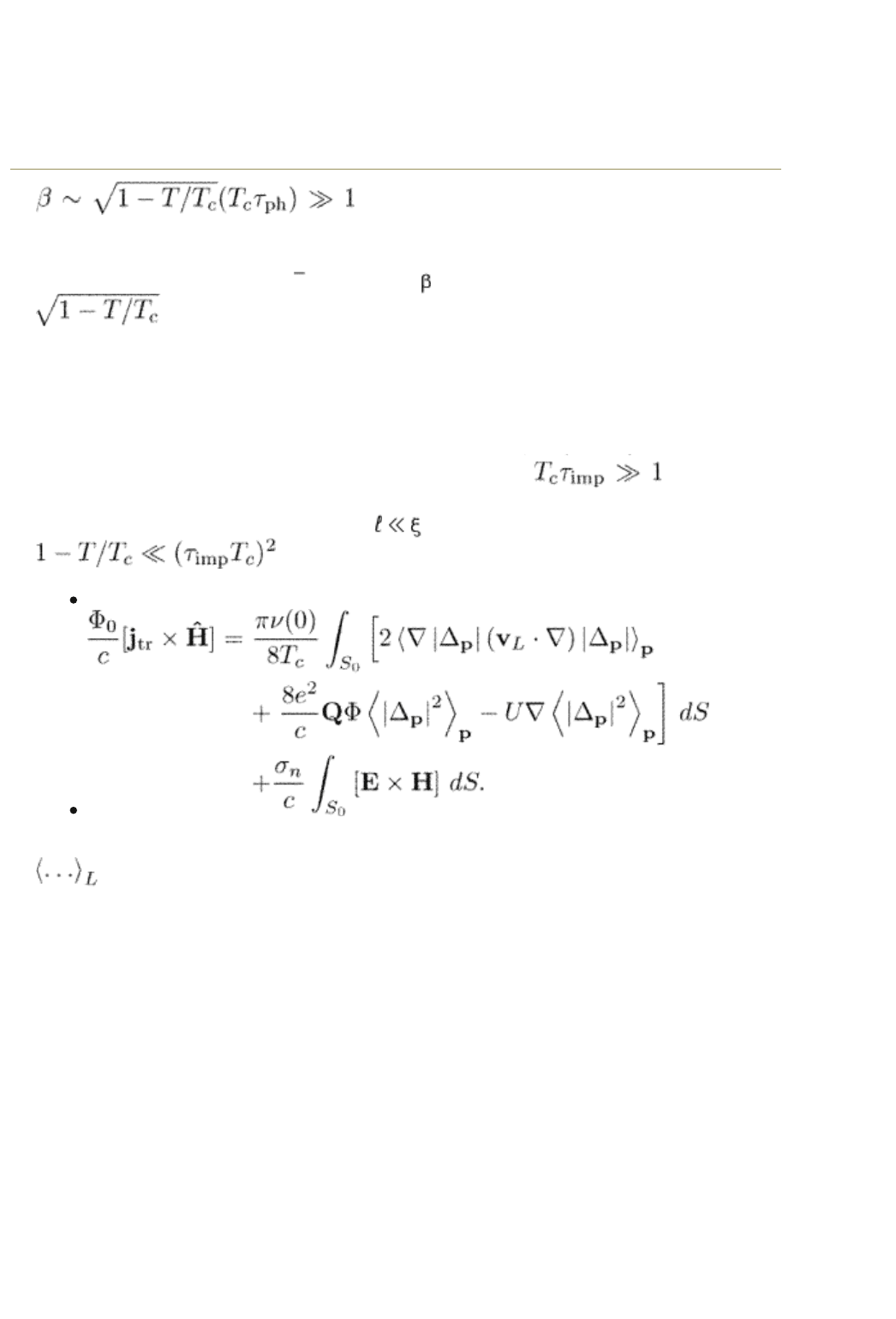
. It is determined by a relaxation of the
order parameter (Tinkham’s mechanism) via slow inelastic electron–phonon
interactions while the contribution from normal currents in the vortex core is
smaller by a factor on order q
2
. The factor decreases proportionally to
when T approaches T
c
.
12.8.2 D-wave superconductors
The same approach can be applied to calculate the flux flow conductivity in a
d-wave superconductor (Kopnin 1998 a) described by eqns (11.46) and (11.47).
We know that d-wave superconductors should be clean, .
However, the applicability of eqns (11.46) and (11.47) requires that the
temperatures are close to T
c
such that (T) which is equivalent to
. We obtain from eqn (12.48)
(12.57)
We keep the subscript p to distinguish the momentum average from the average
taken over the vortex array.
Kopnin, Nikolai, Senior Scientist, Low Temperature Laboratory, Helsinki University of
Technology, and L.D. Landau Institute for Theoretical Physics, Moscow
Theory of Nonequilibrium Superconductivity
Print ISBN 9780198507888, 2001
pp. [251]-[255]
Oxford Scholarship Online: Theory of Nonequilibrium Supe... http://www.oxfordscholarship.com/oso/private/content/phy...
第1页 共7页 2010-8-8 16:03
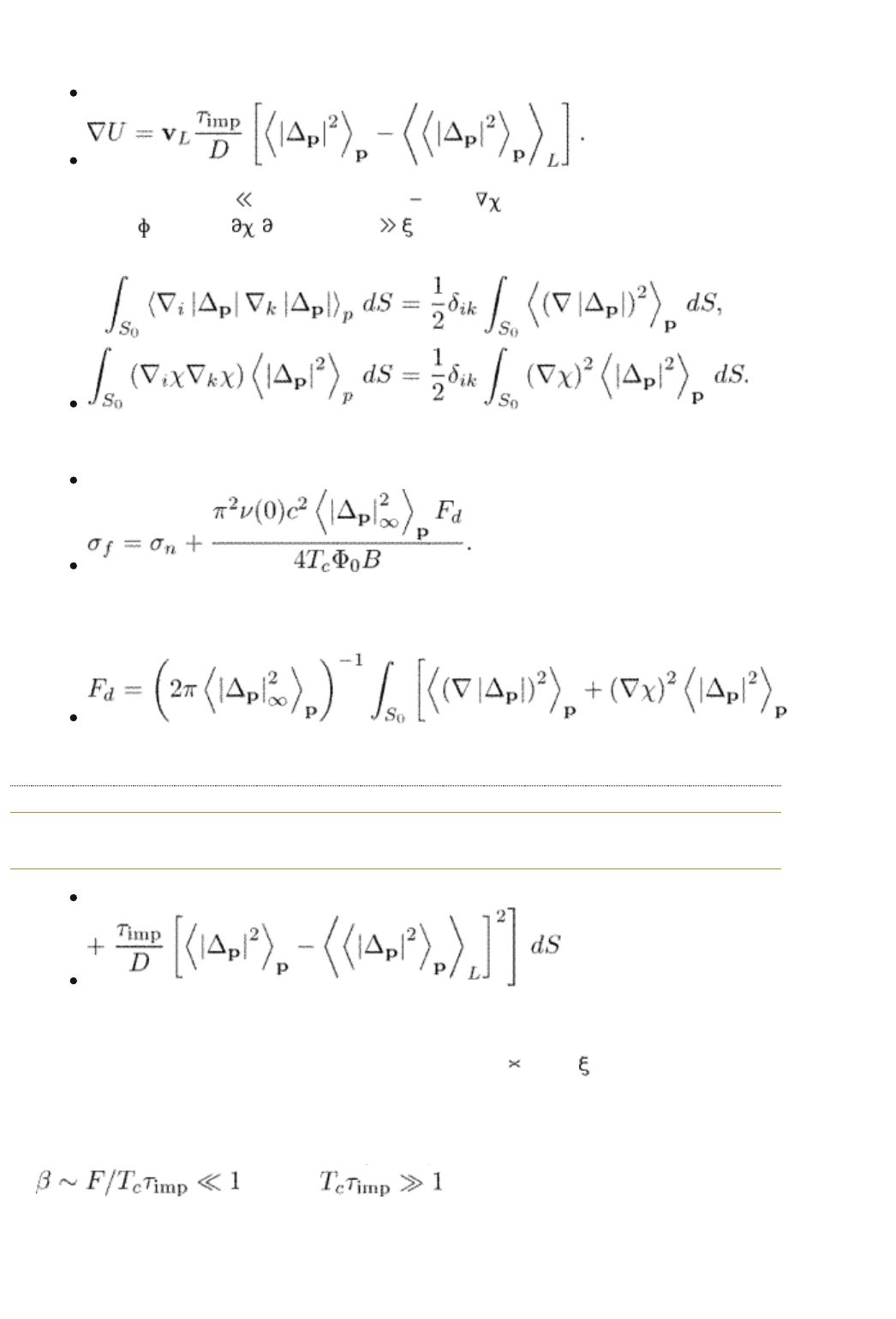
The function U is found from eqn (11.41) under the condition that it does not
increase with distance. Assuming that the diffusion is faster than the inelastic
relaxation we find
(12.58)
In the low field limit H H
c2
we have Q = (c/2e) . Moreover, the scalar
potential is
= (1/2e) / t because l
E
. For a vortex lattice with a symmetry
not lower than tetragonal,
As a result, the flux flow conductivity becomes
(12.59)
Equation (12.59) looks exactly as eqn (12.51) with the difference that the factor
F
d
is now
end p.251
(12.60)
instead of eqns (12.52), (12.53), The largest contribution comes from the second
term under the integral which is logarithmically diverging at distances r ~ R
0
where R
0
is determined by eqn (12.55). Therefore, F
d
ln[R
0
/ (T)]. We had
already such logarithmic divergence of F due to a long relaxation length l
E
in eqn
(12.56) of the previous section. However, it was not important for the flux flow
conductivity of dirty superconductors. On the contrary, it dominates in the
present example. Writing eqn (12.51) in the form of eqn (12.54) we find that
because for a clean superconductor.
12.8.3 Discussion: Flux flow conductivity
We can now summarize the results obtained for the flux flow conductivity within
PRINTED FROM OXFORD SCHOLARSHIP ONLINE (www.oxfordscholarship.com)
© Copyright Oxford University Press, 2003-2010. All Rights Reserved
Oxford Scholarship Online: Theory of Nonequilibrium Supe... http://www.oxfordscholarship.com/oso/private/content/phy...
第2页 共7页 2010-8-8 16:03

the TDGL model. The model identifies two principal sources for dissipation as
sociated with a moving vortex. The first is due to variations of the order
parameter with time as the vortex passes through a superconductor. The simple
TDGL model describes the process of the order parameter relaxation in terms of a
characteristic relaxation time
which is of the order of (T
c
T)
1
. The
generalized TDGL scheme treats this process in a more detailed manner. We
encounter a concept of nonequilibrium excitations which relax through their
interactions with phonons. Deviation from equilibrium is created by order
parameter variations which cause changes in the energy spectrum and thus
produce redistribution of excitations away from equilibrium. The order parameter
returns to its undisturbed value only together with the relaxing excitations. Its
characteristic relaxation time depends now on the electron–phonon mean free
time
:
and is much slower than (T
c
T)
1
when the parameters are outside the gapless
region. This results in a larger dissipation and larger conductivity as compared to
the simple TDGL model.
The second mechanism is associated with currents which flow through vortex
cores. Near a vortex core, the supercurrent converges into a normal current
according to eqn (11.26) through the current conservation (the charge
neutrality)
It is the normal current which dissipates energy. The conversion rate is
determined by the r.h.s. of eqns (1.79) or (11.26), or by the r.h.s. of eqn (11.44)
in the d-wave case. For a gapless regime, the conversion is fast. In our examples,
the gapless regime in s-wave superconductors is associated with magnetic
impurities or with an electron–phonon interaction very near the critical
temperature. Here the dissipation caused by the normal currents is high. In a
gapless situation for
end p.252
a d-wave superconductor near T
c
, it gives even the largest contribution to the
flux flow conductivity. However, the conversion rate is slow in superconductors
which are far from the gapless regime, see eqn (12.56) in the limit
.
The results obtained confirm our general expectation that the vortex dynamics is
governed by kinetics of excitations driven out of equilibrium by a moving vortex.
In the following chapter we consider an example when the kinetics of excitations
creates even larger dissipation than that predicted by the generalized TDGL
approach.
What the generalized TDGL model can not describe completely is the Hall effect
associated with the transverse gyroscopic force on a moving vortex. To conclude
the chapter on the TDGL model, we discuss how one should modify the TDGL
scheme to incorporate at least some possible mechanisms responsible for the
vortex Hall effect.
PRINTED FROM OXFORD SCHOLARSHIP ONLINE (www.oxfordscholarship.com)
© Copyright Oxford University Press, 2003-2010. All Rights Reserved
Oxford Scholarship Online: Theory of Nonequilibrium Supe... http://www.oxfordscholarship.com/oso/private/content/phy...
第3页 共7页 2010-8-8 16:03
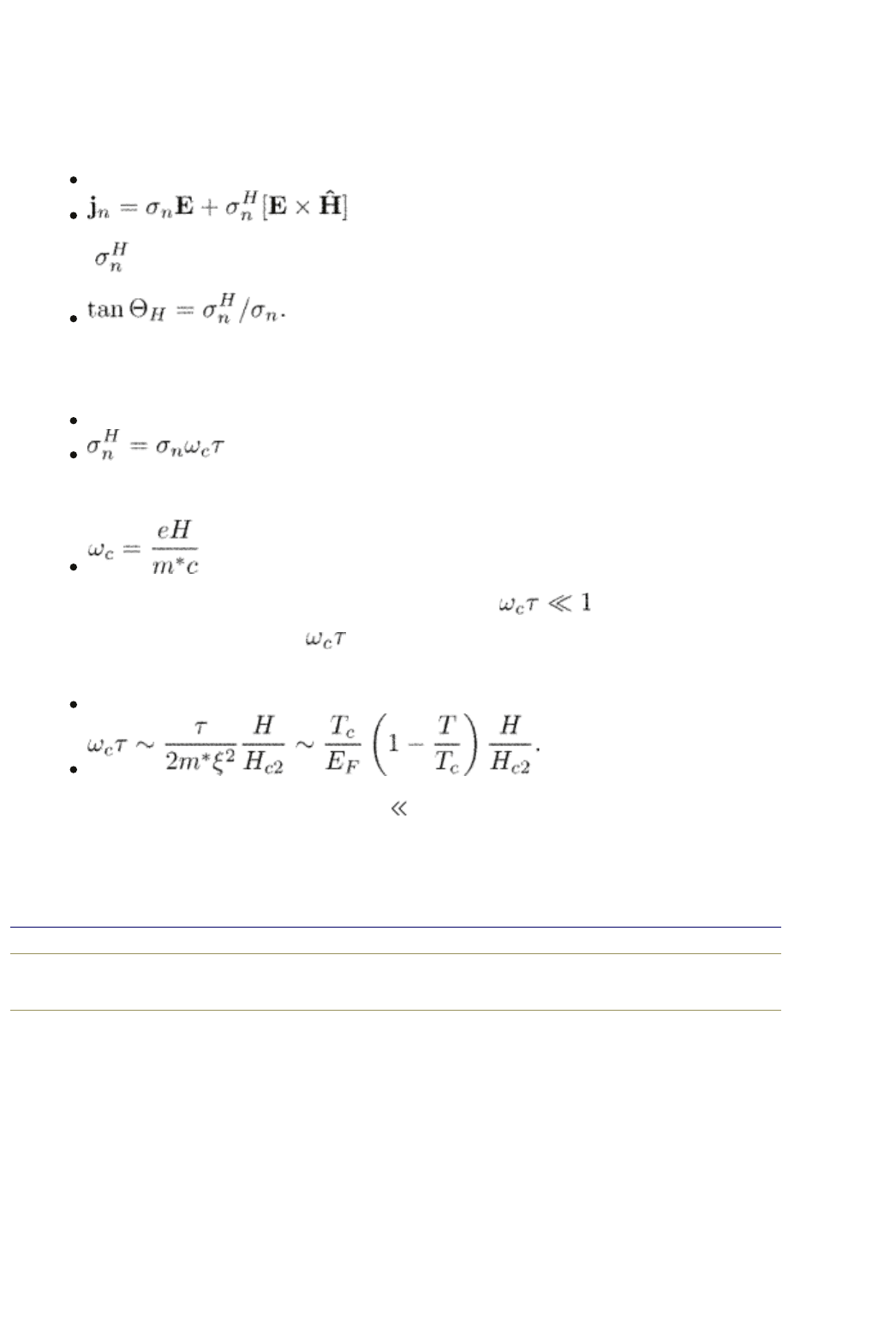
12.9 Flux flow Hall effect
We start with a very brief summary on the Hall effect in the normal state. A
more detailed analysis of the Hall effect in normal metals can be found, for
example, in the book by Abrikosov (1998). In the presence of a magnetic field,
the current in a normal metal has generally both longitudinal and transverse
components with respect to the electric field
(12.61)
where is the normal-state Hall conductivity. The Hall angle is defined as
The Hall conductivity has a simple form for a metal with electronic spectrum E
n
=
p
2
/2m*. For low magnetic fields,
(12.62)
where
is the cyclotron frequency. The low field limit implies .
Let us estimate the parameter for magnetic fields less than H
c2
. For dirty
superconductors
(12.63)
It is very small because, normally, T
c
/E
F
1. In this limit, the Hall conductivity is
much smaller than the Ohmic component and the Hall angle is also small. We
thus expect that the Hall effect in dirty superconductors cannot be large. We
shall see nevertheless, that it exhibits interesting features specific only
end p.253
for the superconducting state. The most interesting property is that the Hall
angle can change its sign after transition into a superconducting state, this is
known as the Hall effect anomaly. The Hall anomaly has been observed in many
experiments starting with the conventional niobium and vanadium type II
superconductors (Niessen et al. 1967, Noto et al. 1976) and later re-discovered
also in high temperature superconductors (see, for example, Hagen et al. 1993).
This section describes the aspects of the flux flow Hall effect that can be
identified within the TDGL theory.
12.9.1 Modified TDGL equations
As we have seen, the usual TDGL theory gives zero Hall effect. This is a result of
PRINTED FROM OXFORD SCHOLARSHIP ONLINE (www.oxfordscholarship.com)
© Copyright Oxford University Press, 2003-2010. All Rights Reserved
Oxford Scholarship Online: Theory of Nonequilibrium Supe... http://www.oxfordscholarship.com/oso/private/content/phy...
第4页 共7页 2010-8-8 16:03
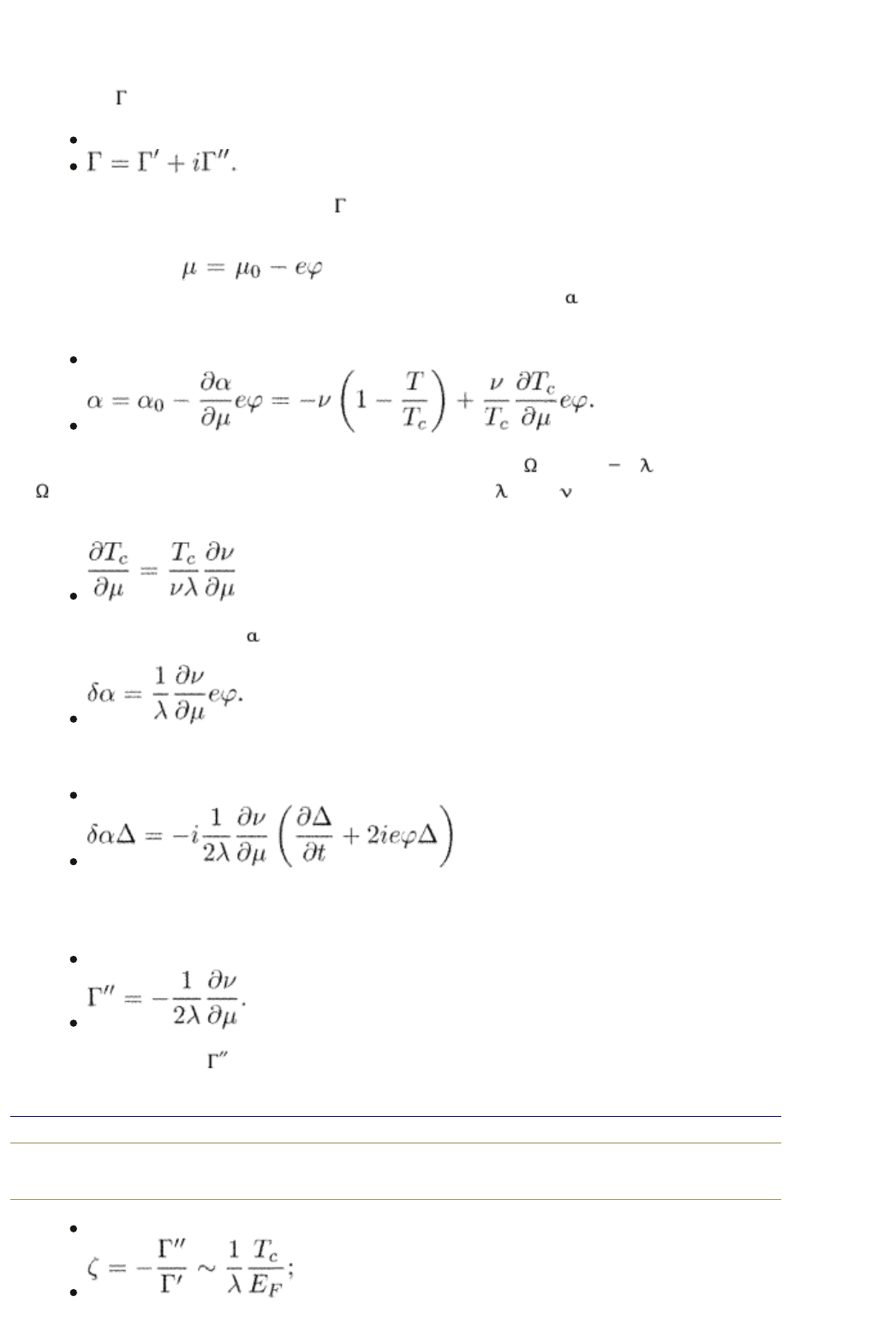
pure dissipative nature of the TDGL equations. To incorporate nondissipative
forces, we have to modify our TDGL equations (Kopnin et al. 1992, 1993, Dorsey
1992). This can be done in two ways. First, we write the normal current in the
form of eqn (12.61). Second, we allow for an imaginary part of the relaxation
constant
(12.64)
The origin of an imaginary part of is as follows (Aronov and Rapoport 1992).
We know that a moving vortex induces a scalar potential proportional to the
vortex velocity. The induced potential adds to the chemical potential of the
superconductor:
. On the other hand, the critical temperature
depends on the chemical potential, therefore, the coefficient
in the GL equation
becomes
(12.65)
Since the critical temperature in the BCS theory is T
c
=
BCS
exp( 1/ ) where
BCS
is the cut-off energy of pairing interaction, and = |g| is the coupling
constant, we have
Therefore, correction to becomes
To preserve the gauge invariance, we should write the correction in the form
(12.66)
which results in an imaginary part of the coefficient in front of the order-
parameter time-derivative
(12.67)
The imaginary part is small
end p.254
(12.68)
PRINTED FROM OXFORD SCHOLARSHIP ONLINE (www.oxfordscholarship.com)
© Copyright Oxford University Press, 2003-2010. All Rights Reserved
Oxford Scholarship Online: Theory of Nonequilibrium Supe... http://www.oxfordscholarship.com/oso/private/content/phy...
第5页 共7页 2010-8-8 16:03
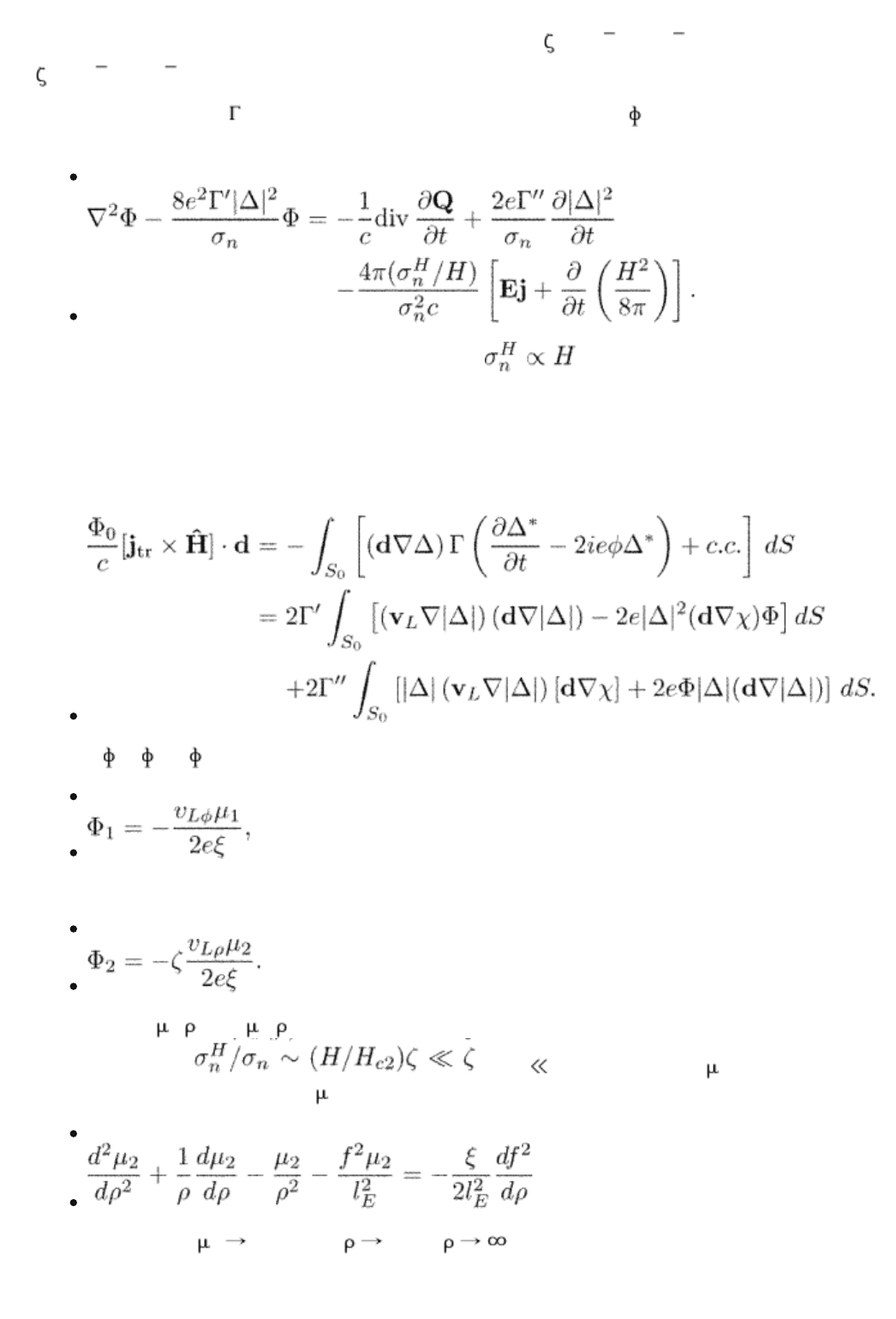
however, it has the correct order of magnitude to account for a Hall effect in dirty
superconductors. For example, for usual superconductors,
~ 10
2
÷ 10
3
and
~ 10
1
÷ 10
2
for HTSC.
The imaginary part of
results in a modification of the equation for . It takes
the form
(12.69)
The last line is obtained under the assumption that .
12.9.2 Hall effect: Low fields
We calculate the Ohmic and Hall components of conductivity in the same way as
in the previous section. The force balance is obtained from eqn (12.15):
We put =
1
+
2
where, as in eqn (12.19),
(12.70)
while
(12.71)
Equations for
1
( ) and
2
( ) follow from eqn (12.69) where one can neglect the
second line, since
for H H
c2
. The function
1
satisfies equation (12.20) while
2
is to be found from
(12.72)
with the condition
2
0 for both 0 and .
The transport current becomes
Oxford Scholarship Online: Theory of Nonequilibrium Supe... http://www.oxfordscholarship.com/oso/private/content/phy...
第6页 共7页 2010-8-8 16:03
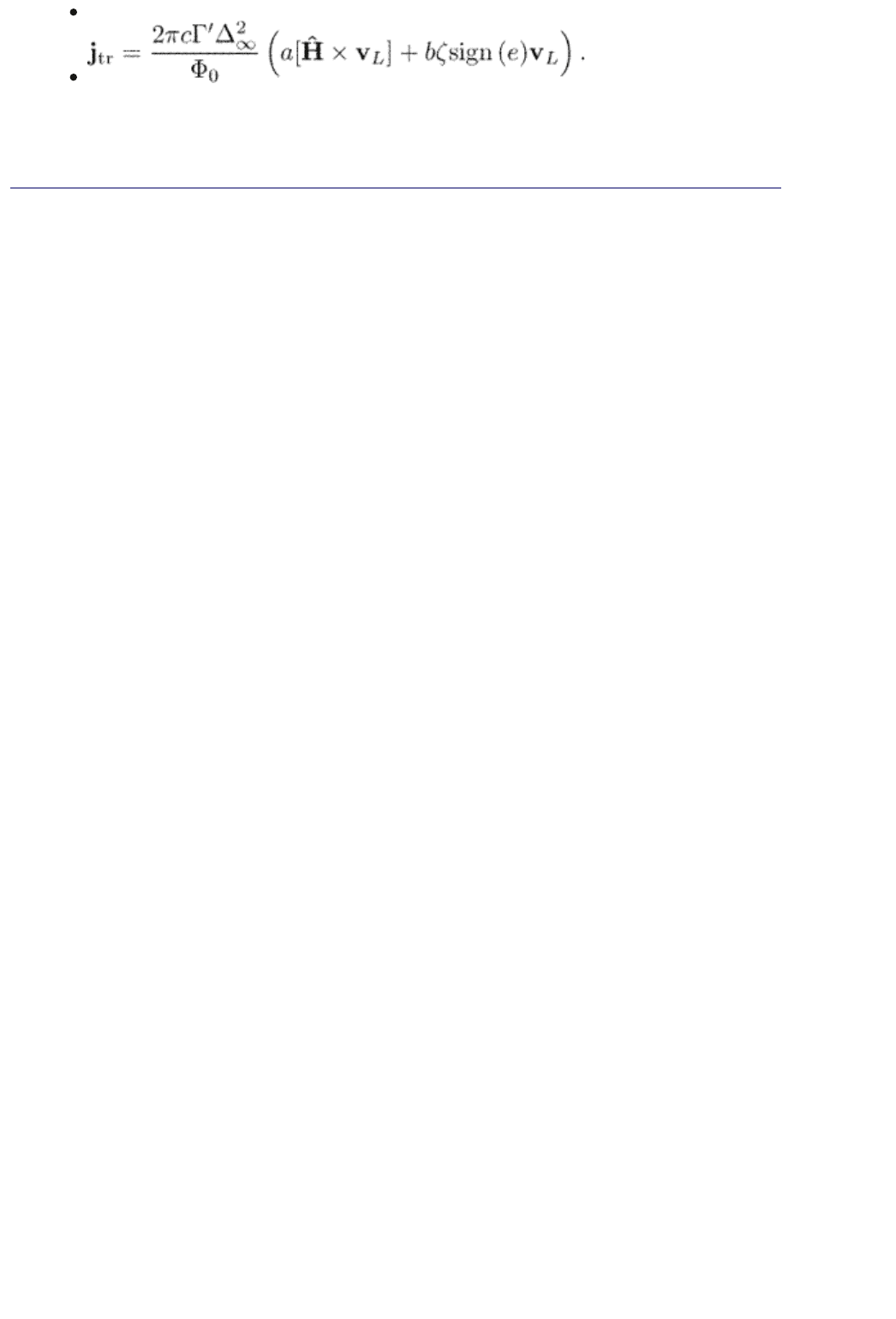
(12.73)
The sign of the electron charge in the second term appears because the sense of
the phase circulation is positive for positive charge of carriers when the direction
end p.255
Top
Privacy Policy and Legal Notice © Oxford University Press, 2003-2010. All rights reserved.
Oxford Scholarship Online: Theory of Nonequilibrium Supe... http://www.oxfordscholarship.com/oso/private/content/phy...
第7页 共7页 2010-8-8 16:03

of the magnetic field coincides with the vortex circulation, and it is negative for a
negative charge of carriers. Expressing the vortex velocity through the average
electric field we find
where the longitudinal (Ohmic) flux flow conductivity
O
is given by eqn (12.24)
with the constant a defined by eqn (12.23). The Hall conductivity is
(12.74)
The constant b is
(12.75)
It is b = 0.27 for u = 5.79.
12.9.3 High fields
Equation (12.15) gives
Using eqns (12.30) and eqn (12.31) we find
(12.76)
The longitudinal (Ohmic) conductivity is the same as in eqn (12.34), while the
Hall conductivity has the form
(12.77)
12.9.4 Discussion: Hall effect
The TDCL model gives, of course, an oversimplified description of the Hall effect.
Kopnin, Nikolai, Senior Scientist, Low Temperature Laboratory, Helsinki University of
Technology, and L.D. Landau Institute for Theoretical Physics, Moscow
Theory of Nonequilibrium Superconductivity
Print ISBN 9780198507888, 2001
pp. [256]-[260]
Oxford Scholarship Online: Theory of Nonequilibrium Supe... http://www.oxfordscholarship.com/oso/private/content/phy...
第1页 共6页 2010-8-8 16:04
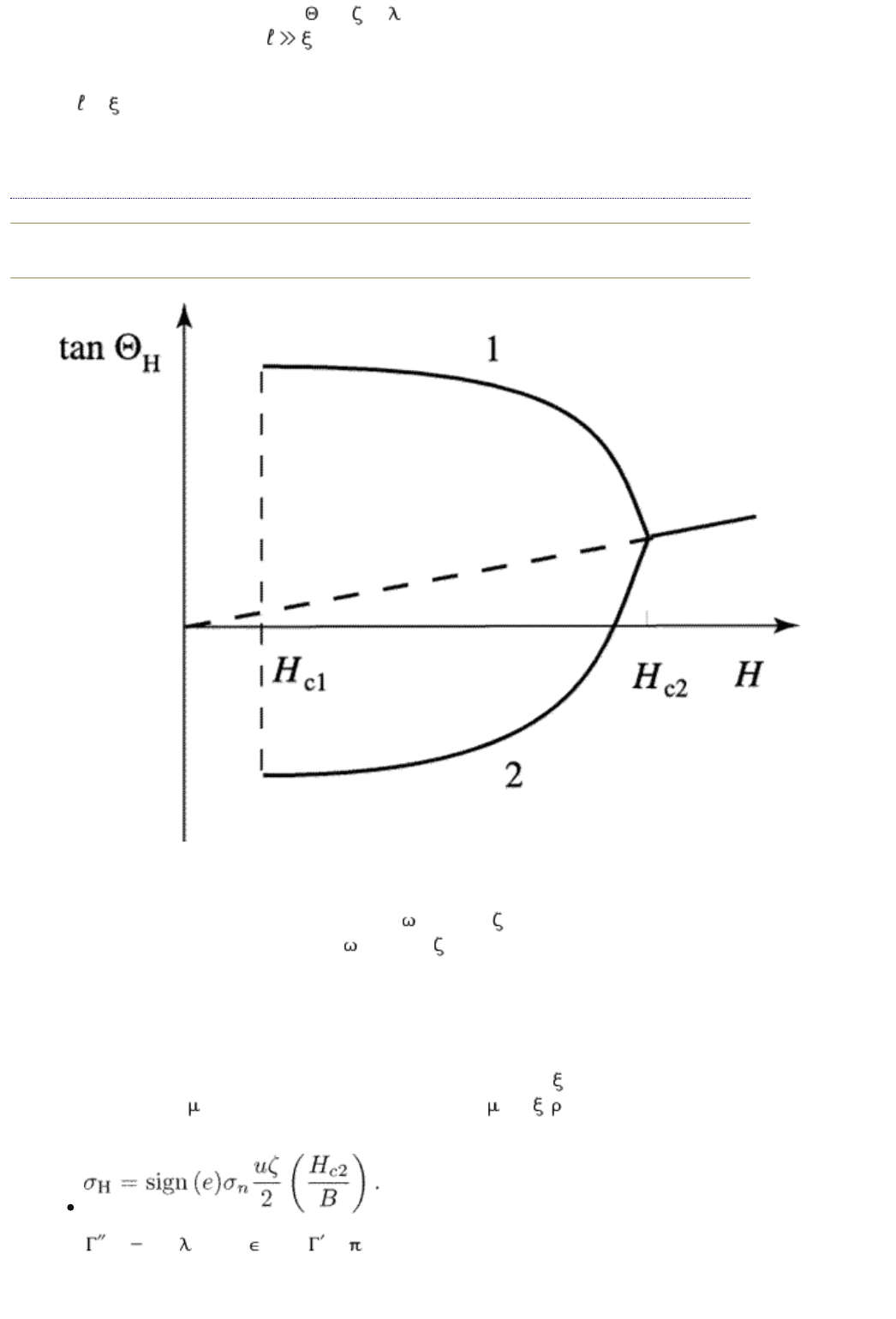
This model predicts a Hall angle
H
~ ~
-1
(T
c
/E
F
). We shall see later that, in
clean superconductors with (T), the mechanisms of the Hall effect are more
complicated. The resulting Hall conductivity appears to be much larger than what
we obtain from our simple TDCJL model except for a relatively short mean free
path
~ (T). However, the contribution which we consider here is also present
in clean superconductors. Indeed, eqn (12.65) is quite general and does not
depend on the quasiparticle mean free path. To make a bridge between
end p.256
FIG. 12.4. The Hall angle as a function of magnetic field. The
sign of the Hall angle is not changed after a transition into the
superconducting state if the signs of
c
and of are the same
(curve 1). The sign reverses if
c
and of have different signs
(curve 2). The thick dashed line is an extrapolation of the
normal-state Hall angle into the super conducting region.
the general situation and the TDGL model we note that, in superconductors which
are far from the gapless conditions like the one considered in Section 12.8, the
electric field penetration length l
E
is usually long compared to (T). In this case,
eqn (12.72) gives
2
= 0 while eqn (12.20) results in
1
= / . In this limit, we
obtain b = 1 and
Using = (1/2 ) (dv/d ) and = /8T
c
with the expression for H
c2
and the
clean-limit value
PRINTED FROM OXFORD SCHOLARSHIP ONLINE (www.oxfordscholarship.com)
© Copyright Oxford University Press, 2003-2010. All Rights Reserved
Oxford Scholarship Online: Theory of Nonequilibrium Supe... http://www.oxfordscholarship.com/oso/private/content/phy...
第2页 共6页 2010-8-8 16:04
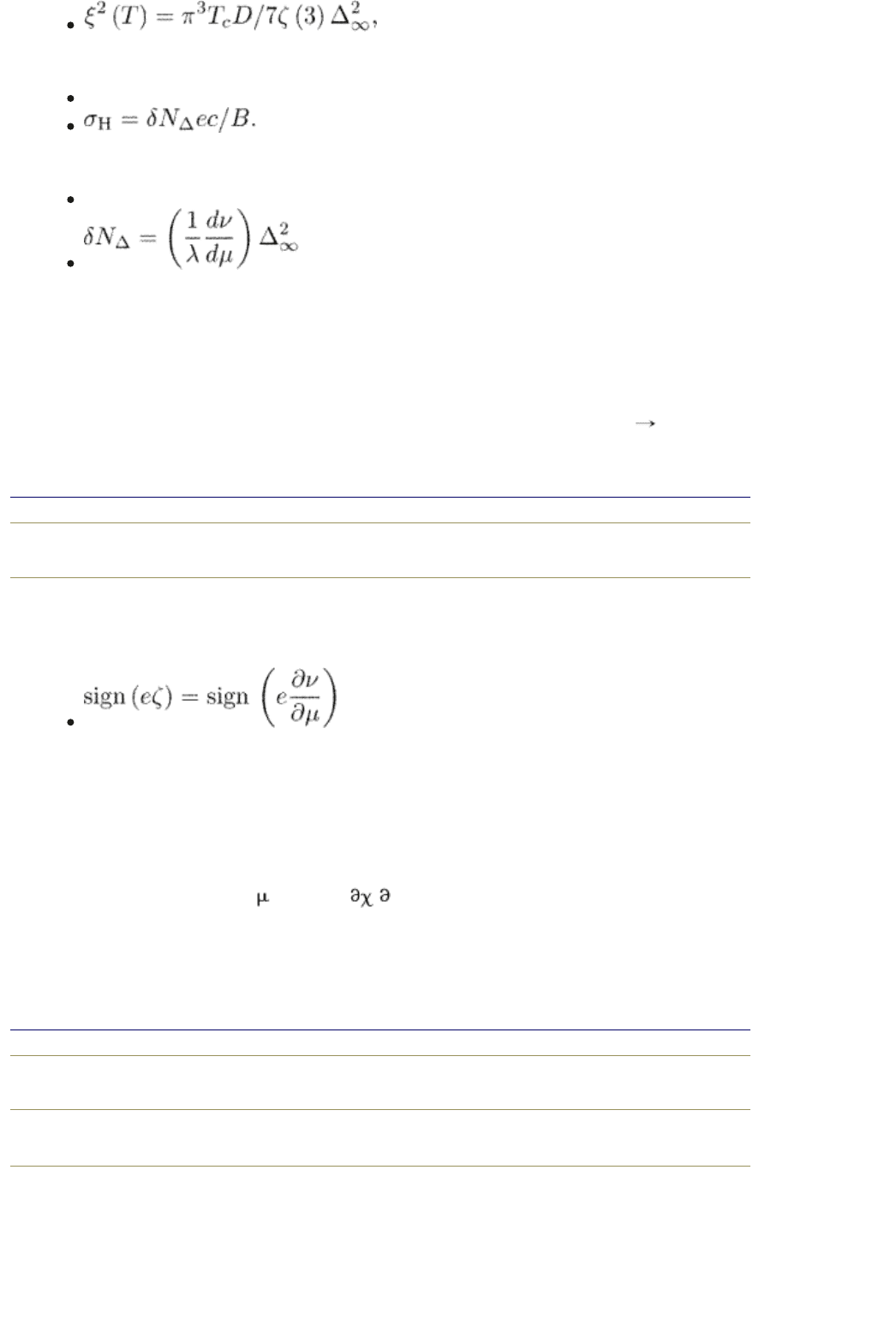
we find
(12.78)
We denote here
(12.79)
the “virtual” variation in the electron density caused by the change in the
electronic spectrum after transition into the superconducting state. Equation
(12.78) was obtained by Feigel’man et al. (1995) and by van Otterlo et al.
(1995). Of course, there is no real density change in a superconductor because of
the charge neutrality: all the variations are compensated by the corresponding
variations in the chemical potential. Equation (12.78) appears to be exact from
the point of view of the microscopic theory (Kopnin 1996) in the limit T
T
c
,
see Section 14.6.2.
end p.257
Note one interesting feature of the obtained expressions for the Hall
conductivities. Equations (12.74) and (12.77) show that the sign of the Hall
effect in the superconducting state near the critical temperature is determined by
which can be different from the sign (e/m*) for a metal whose Fermi surface has
both electron-like and hole-like pockets. If these signs are different, the Hall
angle changes its sign after a transition into the superconducting state and the
Hall anomaly appears (see Fig. 12.4).
The suggested mechanism takes into account the effect of vortex motion on the
pairing interaction due to local variations in the chemical potential of
superconducting electrons
s
= (1/2) / t. This mechanism is of a
thermodynamic nature and is not related directly to the kinetics of
nonequilibrium excitations. We shall see later that interaction of vortices with
excitations in clean superconductors can produce much larger flux flow Hall
effect: excitations play a prominent role again.
end p.258
13 VORTEX DYNAMICS IN DIRTY SUPERCONDUCTORS
Nikolai B. Kopnin
Abstract: The force exerted on a vortex from the environment is derived
microscopically using the quasiclassical Green function formalism. The kinetic
equation is solved for the distribution function of excitations driven out of
equilibrium by the moving vortex. The flux flow conductivity in a dirty
superconductor is calculated. The vortex viscosity appears to be much larger than
PRINTED FROM OXFORD SCHOLARSHIP ONLINE (www.oxfordscholarship.com)
© Copyright Oxford University Press, 2003-2010. All Rights Reserved
PRINTED FROM OXFORD SCHOLARSHIP ONLINE (www.oxfordscholarship.com)
© Copyright Oxford University Press, 2003-2010. All Rights Reserved
Oxford Scholarship Online: Theory of Nonequilibrium Supe... http://www.oxfordscholarship.com/oso/private/content/phy...
第3页 共6页 2010-8-8 16:04
